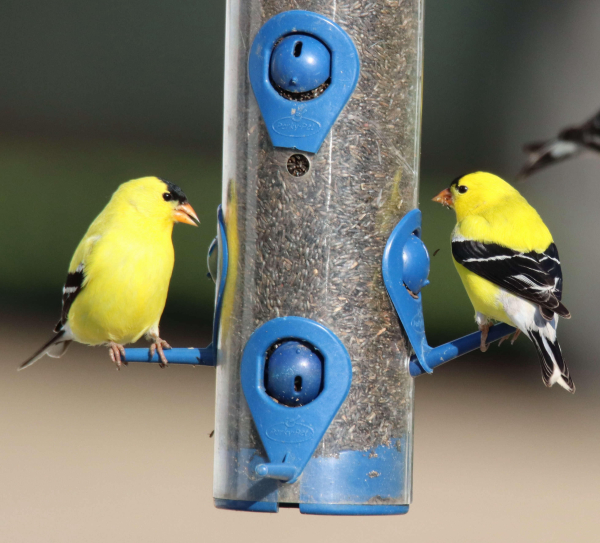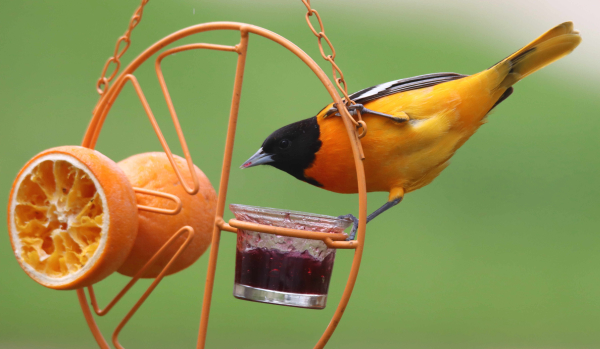
Thistle seeds attract a variety of early spring finches and siskins, attracting more birds as spring progresses, even after American Goldfinches attain their alternate plumage (photos by Paul Konrad).

Orioles, like this Baltimore Oriole, will begin arriving in southern states by mid-April, although it may be 3 weeks later before they reach some northern states. Grape jelly and sliced oranges are oriole staples during spring and summer, and some orioles feed on sugar-water nectar too.
|
Spring migration can bring some of the most interesting, most exciting, most surprising, most appreciated birds to our yards. They arrive as single birds, as flocks, and in mixed flocks, but with the advancing change in weather and with increasing numbers of species beginning migration, it’s time to prepare for the variety of migrating birds. Our best bet to attract a greater variety of birds to our feeding stations is to provide variety at our feeding stations, adding to or even changing the kinds our winter foods we provide as the spring season progresses.
Everyone has a little different situation; with different habitats surrounding feeding stations, including urban and suburban habitats, and others. These variations can create different bird communities at locations just 10 miles apart, much less across a state or the continent. The key is to provide the foods that will attract the birds you most want to share your yard and feeding station with. It’s an exciting time of the year as the potential of new birds appearing on an almost daily basis.
Fill ‘er Up
Some species may quickly pass through your area, some may remain some days or weeks, and others will populate your neighborhood for the winter, or some part of it. Certainly, that’s part of the fun each fall as new species or birds we haven’t seen since spring migration arrive. Don’t miss the opportunity to host a new or favorite species this fall – and any season.
Give your feeding station daily attention. It may simply be a matter of checking to see if there is ample food and fresh water, and when appropriate topping them off. We like to suggest not to wait for a feeder to be empty or your water feature dry before taking action: “Fill feeders and bird baths before they are empty,” we always say.
Fresh Water – We can’t over-emphasize the importance of providing fresh water for birds daily for them to drink and bathe. Water attracts a greater variety of foods than any single food you provide, plus it is easy and free to offer.
Variety – Variety is the spice of life, and a variety of foods attracts a greater variety of foods. By offering thistle seeds, black oil sunflower seeds, and suet, you are providing a great winter mix. We like to add shelled peanuts to that mix too. But by mid-April other foods will come into play, especially sugar-water nectar, grape jelly, and sliced oranges as hummingbirds and orioles advance northward.
Thistle Seeds – Goldfinches, chickadees, titmice, and others may already be regular visitors at your thistle seed feeder, but as other finches are on the move, you may attract Purple Finches, Pine Siskins, and maybe even a few Evening Grosbeaks on their way north.
Sunflower Seeds – Some of the larger finches will prefer larger seeds, along with Northern Cardinals, especially black oil sunflower seeds. If you prefer to avoid the mess of discarded shells, offer shelled sunflower seeds – that’s our personal preference because it keeps our feeding station free of shells, and we aren’t paying for the weight of shells – only seeds. Of course, other popular birds will benefit from high-energy black oil sunflower seeds – nuthatches, woodpeckers, jays, quail, towhees, native sparrows; the aforementioned chickadees and goldfinches, and more.
Seed Mixes – Avoid seed mixes with corn and, frankly, we avoid seed mixes. We get the same birds by providing straight sunflower seeds, and we avoid filler types of seeds that dominate many seed mixes and either end up uneaten on the ground or end up attracting blackbirds, House Sparrows, squirrels, and other rodents.
Suet – A variety of woodpeckers and nuthatches sometimes prefer suet to seeds, although that can depend on individual preferences. Many other birds eat calorie-rich suet too. We provide no-melt suet; in fact, we offer suet made with hot pepper, that essentially repels squirrels, but birds relish it. No-melt provides the option of making suet a year-round feeding station staple.
Bark Butter – A super suet-like blend has been perfected and marketed as Bark Butter and Bark Butter Bits. Talk about attracting a variety of birds, 156 North American bird species are known to feed on Bark Butter, marketed exclusively by Wild Birds Unlimited.
Peanuts – Popular with a variety of birds, peanuts are favorites with jays, woodpeckers, nuthatches, and most seed-eating birds. We offer shelled peanuts as a daily treat, rather than keeping a feeders filled to capacity. We avoid attracting unwanted birds like starlings and rodents, including squirrels, by feeding peanuts in a squirrel-proof feeder, or a feeder hung on a predator-proof/squirrel-proof pole or hanger. If you are a squirrel person, we’d suggest setting up a special squirrel feeding site, which is positioned out of sight from your bird feeding station, keeping a bird feeding station where birds are not competing with the dominating actions of squirrels and chipmunks.
Keep it Clean – Of course, it’s important to keep your feeders clean, especially during migration. It’s equally important to keep the area surrounding your feeding station clean. Any “mess” will mostly include seed shells on the ground, primarily sunflower seed shells and peanut shells, which can be avoided by stocking your feeding station with shelled seeds. It beats raking, shoveling, and disposing of seed refuse regularly; but the bottom line, keep is: Keep your feeders, water feature, and the area around your feeding station clean.
Late Spring Additions
By mid-April, which is not that far into the future, it’s time for everyone to be ready for migrating hummingbirds and orioles, although in some areas these late migrants won’t arrive until mid-May. Even so, it’s important to be ready before you see the first hummers or orioles. Are your hummingbird feeders and oriole feeders in good repair? Are you satisfied with their ease of filling and cleaning? Are they an attractive addition to your feeding station? Are you shopping for new feeders for this spring? Now’s the time to make that happen so you are ready in advance of these late migrants’ appearance in your neighborhood.
Sugar-water Nectar – There are some options for hummingbird nectar, but the key ingredient is white cane sugar mixed with water in portions of 1 part sugar with 4 parts water. Another option is to use a pre-mixed sugar-water nectar, which also often requires you to dilute the mix with water, but it eliminates dissolving sugar and some of the mess involved. Keep in mind too that hummingbirds get their protein from small insects they feed on, and flower gardens are often a prize feeding location for hummingbirds.
Of course, hummingbirds are a regular part of the avifauna for lucky birders in areas of southern California, southern Arizona, southern Texas, and southwest Louisiana where feeding hummingbirds may be a year-round practice. Some orioles and House Finches will appreciate sugar-water nectar too.
Grape Jelly & Oranges – Most orioles migrate south of the American border, except some Baltimore Orioles overwinter throughout the Florida peninsula; plus Altamira Orioles are full-time residents of southern Texas. In these areas you will want to provide grape jelly and sliced oranges to attract colorful orioles, and some other birds may feed on the oriole preferences too.
Landscaping – Foraging areas, cover, roosting sites, shelter nesting locations – backyard habitat – including a variety of bushes, trees, flower gardens, mowed and longer grasses, emphasizing native plants. This spring, consider leaving some areas a little messy for thrashers, towhees, native sparrows, and juncos to forage among fallen leaves and flower heads leftover from last fall. We like to leave some edges along bushes, trees, and other areas unmowed, allowing grasses to seed early and provide a little more cover for ground-oriented birds. And in southern areas its already time to visit your local greenhouse to select the first flowering plants to add to your yard. Remember, hummingbirds like red flowers best (they produce the highest sugar content in their nectar).
It's an exciting time for birders as spring migration brings new birds into our neighborhoods. When will the first robins begin singing in your yard? Enjoy the coming season, and be prepared.
Share your backyard birding experiences and photos with The Birding Wire at editorstbw2@gmail.com